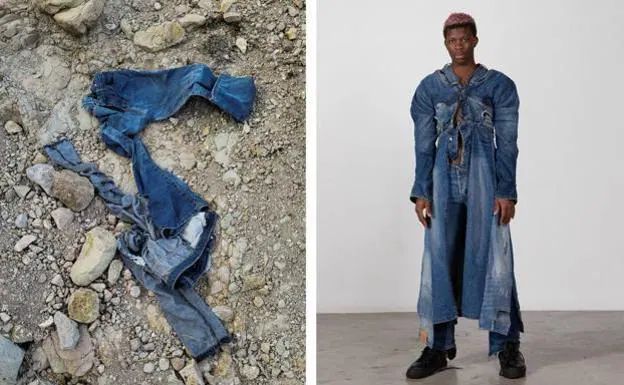Haute couture that arrived in a boat
Designer Ernesto Artillo has recycled clothes abandoned by migrants on the beach in his Illegal Collection, a reflection on the human drama and environmental impact of the textile industry
REGINA SOTORRÍO
MALAGA.
Friday, 17 February 2023
On the model it looks like a frayed shawl, a shirt torn and shredded on purpose to create a transparent effect. But no: the story of this garment is very different. What is today an item of haute couture was, more than a decade ago, a piece of wet clothing hurriedly taken off by an immigrant when he arrived on the beach at Cabo de Gata in a small boat. This is the Zaira brand, a crude imitation of Zara. Years in the sun, in an isolated cove, have altered the fabric and left it the way it looks now in the Ernesto Artillo's Illegal Collection which he presented at the We Collect gallery in Madrid on Wednesday.

The artist, who was born in Malaga but now lives in Cabo de Gata, dignifies the clothes which are abandoned by migrants on the Almeria coast. "Textile corpses" he calls them, which he revives after a meticulous and repetitive process of hand-washing, disinfecting and restoring. It was something that came to him spontaneously when he realised that the "paradise" that he had moved to was the place that others came to when they were fleeing from "hell". Instinctively, he began to pick up the shirts, the tracksuits, the coats and jeans that he came across. And he photographed them as they lay there first, to record the state they were in and the place he discovered them. Some even appeared outside the entrance to his house. "I couldn't take my eyes off them," he says.
Then, as if they were exclusive fabrics he was dealing with, he cared for them, treated them with delicacy even though he didn't know what he was going to do with them. He felt the "need" to do that. In some cases, insects had nested in the seams. In others, plants had torn the fabric. "When you see them, you understand everything better. You are seeing how they got there and how, when people came out of the sea, they would take off their wet clothes behind a bush or a rock. There are clothes discarded by men, women and children; I have even found very small trainers. It gives you a lot of information about them. It's a way of following in their footsteps," he says.

After several months picking up items of clothing, Artillo piled them into a boat and paraded them through the village as a penance, a reminder of those who make the crossing. Then he decided to give them a new life and recycle them to give them meaning. "I wanted to dignify them by treating them as haute couture, in recognition of the tough process they have already been through as clothes and the drama that lies behind them," he explains.
Artillo is no stranger to the world of fashion. He has designed powerful advertising campaigns for international brands and created his own fashion items for a collection called The Woman I Wear Outside, which highlighted issues related to feminism. Now he is tackling the unsustainability of the textile industry and its impact on the environment, but above all he addresses human rights. "Using such a superficial format in contrast to something that has to do with human survival makes us react," he says. And, in fact, it shocks.
The clothes which have suffered most from the passage of time are exhibited as they were found, with nothing more done to them than cleaning. But Artillo does embroidery work and more elaborate tailoring on the more recent ones, those which were discarded the night before he found them, or even on the same day. They are often imitations of designer names: jeans by Prada or Balenciaga, sweatshirts by Givenchy or Gucci socks. And this is where the three concepts that run through this collection come in: penitence, patriotism and song.

For Artillo, immigration is "the pilgrimage with the most faith in Andalucía" because people really are risking their lives for something they believe in. It is also an act of patriotism. "I found a Reebok tracksuit with the Spanish flag on it. What could be more patriotic than crossing the Mediterranean like that?" he asks. And on some trousers he has embroidered the words of the song El Emigrante. Most of the work for this collection was done in collaboration with the Estación Diseño school in Granada during an intensive one-week workshop where the pupils applied their knowledge to a real project.
Following the presentation in Madrid the designs are being sold as pieces of art and 50% of the profits will be donated to ACCEM, an association that works to improve the living conditions of people at risk of social exclusion. The money will buy clothes for families evicted from settlements in Almería. It is a way of closing the circle.
